Potato leafhoppers have been found in Massachusetts. Waiting for visible damage to show on your plants is too late for avoiding yield losses, so if you grow beans, potatoes, eggplants, strawberries or hops, now is the time to start scouting for them. Basil downy mildew was found in Rhode Island and on Long Island recently, so there’s some potential for this to be a year we see it early in Maine. Even though the cold spring has delayed berries around the region (and many suffered winterkill losses), spotted wing drosophila has already been found in southern New England.
Remember that the pest alert is descriptive, not prescriptive! Many of these pests will not find you, and often the problem is not the worst case scenario that our written description of symptoms may make them seem to be. Just know these pests could be there and keep your eyes peeled – an ounce of prevention is worth a pound of cure as the saying goes. Along those lines, I’m reminding folks of the leek moth, a newer pest slowly making its way into northwest Maine. Adult leek moths’ second flight is occurring now in Vermont and New Hampshire, and that’s the most potentially damaging generation in a given year.
I do not think that we have too many growers of celery, but I saw some celery anthracnose last year and Elizabeth Buck’s recent write up was too well written to not include.
Lastly, remember that clicking on an image will open a new browser tab with a larger copy of the same image.
Potato Leafhopper Alert
Early Blight
Basil Downy Mildew
Celery Anthracnose
Three Lined Potato Beetle
Spotted Wing Drosophila
Leek Moth
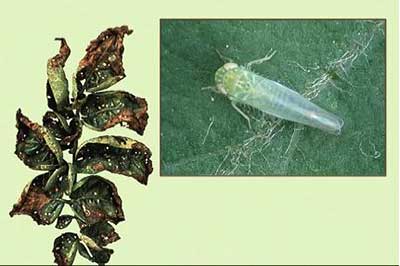 |
| Potato leaves damaged by leafhoppers (left) with leafhopper (right) greatly enlarged. |
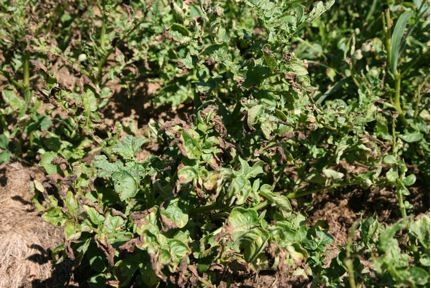 |
| Leafhopper damage on potato leaves, called “hopperburn.” |
POTATO LEAFHOPPERS
(Empoasca fabae)
By Eric Sideman
The potato leafhopper has been arriving here in New England earlier and earlier. If you see unexplained yellowing of leaves of beans or potatoes, check for the critter. They primarily feed on beans, potatoes, eggplants, strawberries and alfalfa, but will also damage hops. PLH does not overwinter anywhere near here. They overwinter way down south on the coast of the Gulf of Mexico, and leapfrog up here in mass migrations. Sometimes hardly any make it, and other years there are massive numbers. Once they get here there are a few generations during the season and often become a bigger and bigger problem. The first to arrive are females, and they are usually carrying fertilized eggs when they get here. They first land in trees, but quickly search out vegetable crops.
The damage from leafhopper is catastrophic. The bug sucks the juice out of the plant and injects a toxin that clogs the food conducting tissue. The symptoms look like a disease after a while, rather than insect damage, and is frequently mistaken as such. The leaves first get pale, then yellow and then brown from the edges. Then the plant dies. The symptoms are called hopperburn.
The adult PLH is very light green and wedge shaped and tiny (an eighth of an inch long). The best way to find them is to brush the plant, see a bunch of this tiny things fly up, and watch one of the white-looking bugs land. The nymphs are similar to the adult, but have no wings and are even smaller. Nymphs live on the underside of the leaves. If you disturb a nymph you will see it run and it can run sideways as fast as forward. This is a clue that you have PLH and not some other less harmful species of leafhopper.
The adults are flighty. When you brush your crop you will see them fly up. If there is a cloud of them, you are in trouble. Researchers have developed a threshold before treatment is recommended. Thresholds vary but here is one that is typical: Treat potatoes if 5 adults or 15 large larvae are found on 50 leaves.
Crop rotation does nothing for you with this pest, since they are coming from far away. Covering your crops with a row cover works well. Effective insecticides are limited. The only material that I have seen work that is allowed in organic production is pyrethrum, so Pyganic is the recommendation that I make. Spray in the evening, get good coverage including the undersides of the leaves, and don’t wait until it is too late. If you wait to see leaf symptoms, it is too late. Plants will not recover.
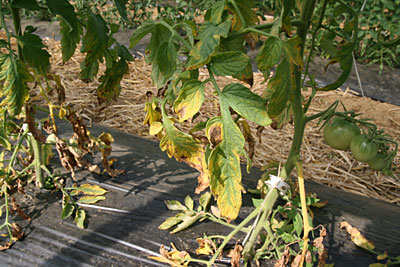 |
| Early blight on tomato |
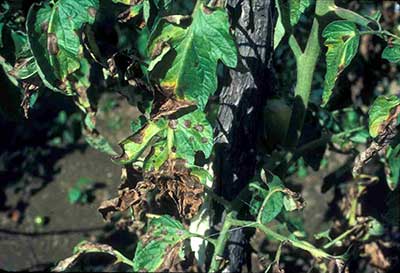 |
| Another view of early blight on tomato |
EARLY BLIGHT ON TOMATO
(Alternaria solani)
By Eric Sideman
Early blight is a serious problem in tomatoes and potatoes, but rarely affect peppers and eggplants. In most years, it is very common; much more common than late blight, which is usually rare in Maine anywhere other than the County.
All aboveground portions of the plant can be affected throughout the growing season. The disease starts on the lower leaves with small, circular spots that resemble a target with their concentric rings. Leaves develop yellow blighted areas, eventually turn all yellow and die. The tomato fruit may rot on the stem end. Though rare, potato tubers can also become infected. The pathogen overwinters on diseased plant residues in the soil. Initial infection is from splashing up from this overwintering site. However, by mid-summer, most of the infection is coming from spores blowing in the wind from the widespread infection in gardens and on farms across the region.
It is important to avoid early on-set of the disease because the longer you can avoid the problem the more likely it is that you will harvest red tomatoes before the plants die.
Here are some cultural practices that can help avoid this disease:
- Use crop rotations of at least three years to non-hosts (i.e., away from tomato, potato, and eggplant). Once the plant residue decays, the pathogen is gone.
- Provide optimum growing conditions and fertility. Stressed plants (including drought or excessive moisture or shade) are more susceptible to early blight.
- Stake or cage plants to keep fruit and foliage away from soil, and promote quicker drying.
- Drip irrigation is preferred. If using overhead irrigation, start before dawn, so plants are dry early in the day. The key is to keep the period of leaf wetness to a minimum.
- Mulching helps to prevent splashing of spores from soil up to lower leaves.
- Indeterminate tomato and late-maturing potato varieties are usually more resistant or tolerant to early blight.
- Each season, disinfect stakes with an approved product before use. Sodium hypochlorite at 0.5% is effective and must be followed by rinsing and proper disposal of solution. Hydrogen peroxide is also permitted.
- Grow tomatoes in a high tunnel or caterpillar tunnel. Tomatoes grown with such protection rarely suffer from early blight because there is less splashing up from the soil and fewer wind-blown spores, and the leaves remain drier.
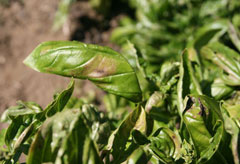 |
| Downy mildew of basil. Eric Sideman photos |
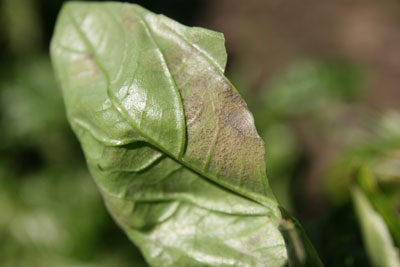 |
| Downy mildew spores on bottom of leaf |
BASIL DOWNY MILDEW
(Peronospora belbahrii)
It is very early in the season to be mentioning this problem, but it’s been found nearby so let’s be careful. Seedlings that are already infected with basil downy mildew are sometimes sold, and so it is possible that gardeners all over can introduce the pathogen to their fields. The extent of the spread will depend on weather conditions. Be on the lookout if you purchase seedlings.
This is a pretty new problem, and it can be widespread. Downy mildew of basil was first reported in Uganda back in 1930. Recently it has been getting lots of attention as it spreads, first to Italy in 2004, France in 2005, United States (Florida) in 2007 and by 2009 New England.
The first symptom is a pale yellowing of the upper surface of the leaves, quite similar to sunscald. Later, vein-bounded patches of dark spore production can be seen on the lower surface. This develops into a gray, fuzzy growth typical of downy mildews of other crops. At first you may be able to convince yourself that some soil has been splashed onto the underside of the leaf, but soon the plants will be going down and it will be clear that it is not a problem that can be washed away.
The disease may be seedborne, but that is probably a very rare event. The spread is most likely due to the wind-blown spores. In the damp conditions of the early and mid-summer they could move far and wide. There is also some belief that seedlings already infected and moved across country for sale play a role.
The infected leaves are safe to eat, and reports from growers are that mildly infected leaves still make a fine tasting pesto. Some types of basil are less or not susceptible at all. For example, Thai basil is almost always fine. At least one grower reports that lemon basil is not susceptible, and that the purple basil seems a bit less susceptible.
The common sweet basil is the most susceptible. The folks at Johnnys and lots of others are working hard to get resistant varieties and have some in their catalogs noting some resistance, though it’s always good to hear from growers if resistance is really making a difference for them. For now, if you see downy mildew on the variety you are growing, make pesto fast.
Anything that will allow leaves to dry quickly will help, e.g., weed control, good spacing, venting tunnels, watering in the morning instead of the evening, etc. One strategy is to make new plantings every 3-4 weeks in hopes that if the spores come in and infect one planting it can be destroyed it so it does not release spores, and there will be another planting waiting in the wings. Some growers have claimed that they caught symptoms early, cut plants back hard before a stretch of sunny dry weather, removing all leaves (critical to the success of this approach), and that later regrowth avoided infection as there were no infected living leaves to act as a source of inoculum.
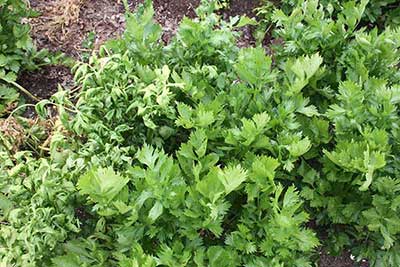 |
| Celery infected with anthracnose on left and uninfected on right |
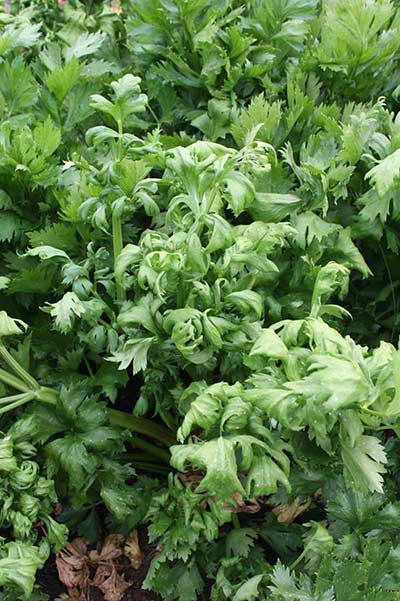 |
| Leaf curl caused by celery anthracnose |
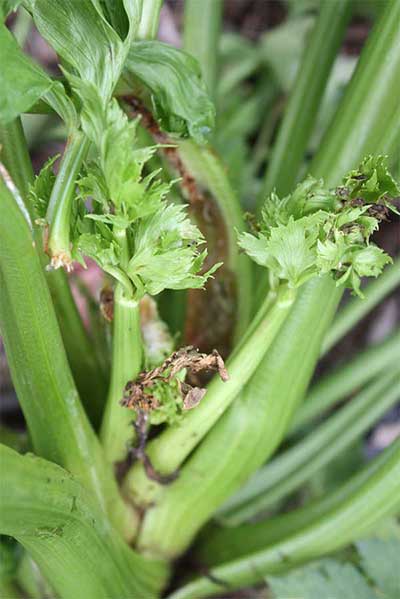 |
| Celery anthracnose lesions allowing soft rot to enter |
CELERY ANTHRACNOSE: The Leaf Curl Disease
Adapted from an article by Elizabeth Buck, Cornell Vegetable Program, with added photos by Caleb Goossen (original article available here, with author’s photos)
Since 2010 celery anthracnose (aka leaf curl) has become a major challenge in large celery production regions in Michigan and Ontario and sporadically occurs in the Northeast. It attacks celery plantings and does not appear to affect celeriac or other closely related crops.
Symptoms, listed from the first noticeable to the most severe, include:
- Small, slightly sunken, light brown elliptical lesions or cracks on the stalks
- Curling leaves (usually downward cupping) and twisting petioles
- Pale green (not yellowed) color +/- stunting
- Sunken dark brown or black lesions along stalk edges, particularly on young heart tissue
- Ruptured, greenish to light brown outer stalk lesions, frequently with gall tissue or adventitious roots on the inside
- Slimy, brown to black rot of the heart tissue that leaves intact outer leaves standing
The anthracnose species responsible for rots in tomato and pepper do not cause celery leaf curl. Celery anthracnose is caused by a tightly related cluster of Colletotrichum (pronounced cauli-tot-richum) species formerly referred to as Colletotrichum acutatum. Researchers have just recently been able to use genetic identification techniques to determine that at least two species in that old grouping cause celery leaf curl – C. fioriniae and C. nymphaeae. Both cause disease in fruit crops; C. fioriniae is responsible for bitter rot of apples while C. nymphaeae causes strawberry anthracnose.
How celery anthracnose arrives on farm is unclear. Some recent work suggests that seeds may carry the disease, and helps explain why symptoms often start in greenhouse transplant production. Celery leaf curl is easily spread in the field by water and splashing soil. The life span of celery anthracnose in the soil isn’t well understood at this point. Once on the farm, celery leaf curl fungi can infect several weeds. Common lambsquarters, redroot pigweed, yellow nutsedge, oakleaf goosefoot, and common groundsel all harbor celery anthracnose without clearly expressing symptoms themselves. This is an important feature of celery anthracnose: the disease can infect a plant then lay quietly in an asymptomatic state (a latent or quiescent infection) until environmental conditions become favorable.
Celery anthracnose thrives under warm, wet conditions. Rapid growth occurs when temperatures are 77o – 86o F, with substantially more disease development at 86 than 77. Temperatures as cool as 60 will support fungal growth and spread, but field progression will be slow. Wet leaves also facilitate leaf curl development. Long wetting periods of 48 – 96 hours are most conducive to outbreaks, though as little as 12 hours is sufficient to cause disease. It takes 3-5 days after infection for the small, sunken stalk lesions to appear. The curling starts just days after the initial lesions. Celery leaf curl frequently develops when it has been very hot with heavy thunderstorms followed by high humidity. Overhead irrigation and poor airflow due to weedy fields also increase leaf wetness periods and exacerbate disease.
Full disease outbreaks in celery can cause heavy losses. When environmental conditions favor disease, infection can range from 17% to 100% and cause marketable yield loss of 2% – 80%. In cooler, drier weather, infections can be as low as 1% – 10% with very little to no loss in marketability. I’ve seen field losses ranging from 20% to 100% on New York farms. If an infection is mild and the heart tissue is unaffected, some plants with celery leaf curl can be marketed after an aggressive trimming.
So, what to do about celery leaf curl? For starters, become familiar with the symptoms. Next, keep the greenhouse free of weeds – a relevant practice for most crops because greenhouse weeds are a common source of pests and diseases. Scout your plug trays before transplanting into the field. Remove suspicious seedlings and treat the remaining ones, or consider starting over using new plug trays. Don’t plant them into fields with a history of celery anthracnose. Right now there isn’t enough understanding of how this disease works to say if C. nymphaeae will move from strawberries to celery and vice versa. Assess your comfort level for rotating those two crops, especially following strawberries that had anthracnose. To be cautious, don’t move from an infected celery or strawberry planting into the other crop when doing field work. Use drip irrigation if there is celery leaf curl in the transplants. Using plastic or other mulch will help reduce splashing and weed pressure.
Scout your celery planting during a long hot period or a few days after a short one. Hold off on scouting until the foliage dries. Pay particular attention if you’ve had heavy rain, high humidity, or overhead irrigation. Look for curling leaves and then examine the stalks and hearts of plants more closely. Remember that aster yellows would require the presence of leaf hoppers for transmission, produces pronounced yellowing, and does not cause dark stem lesions. Remove infected plants to minimize field spread of celery anthracnose. Control weeds in infected fields to improve airflow and reduce the risk of carryover on weedy hosts. Minimize overhead irrigation if possible. Harvest fields with infections as soon as the plants are of marketable size to reduce the chances of developing heart lesions. Fields with celery leaf curl should be turned in to incorporate infected crop residue and promote break-down. The current recommendation is to rotate away from celery for 3 to 4 years.
Some varieties show some tolerance to celery leaf curl, though no variety is resistant and all varieties screened to date will show some disease.
Table 1. Variety selection for celery anthracnose mitigation
| Least susceptible | Moderately susceptible | Highly susceptible |
| Merengo | Sabroso | Plato |
| Hadrian | TZ 6010 | TZ 9779 |
| Geronimo | Stetham | |
| Balada | Kelvin | |
| Nero | ||
| Green Bay | ||
| Dutchess |
While celery may not be a major crop in the Northeast, celery anthracnose tends to cause major losses when it shows up. There is ongoing research into celery leaf curl in Ontario and Pennsylvania which will hopefully lead to future improved control.
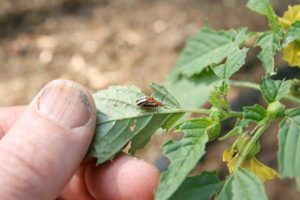 |
| Three-lined potato beetles. Photo by Eric Sideman |
THREE-LINED POTATO BEETLE
(Lema daturaphila)
By Eric Sideman
Cucumber beetles on my potatoes and tomatillo?
No. Those are not cucumber beetles. Potatoes, tomatoes and sometimes eggplants are attacked by the three-lined potato beetle that only superficially looks like a cucumber beetle. Its favorite food is tomatillo and husk cherries (both are Physalis species). The adult of this pest is about the same size as a cucumber beetle but has a reddish head and a thorax with two dark spots. The wing covers are dark yellow with three black stripes.
The Three-Lined Potato Beetle overwinters as an adult and wakes early in the spring. They are there waiting for you to plant your solanaceous crops. The females soon begin laying eggs that hatch in about two weeks to larvae that look a bit like Colorado potato beetle larvae, except these critters have the endearing practice of carrying a small pile of their own excrement on their back. The larvae mature in about two weeks. There are probably two generations per year.
On most crops, the damage from this pest does not warrant control. If three-lined potato beetle has been a problem in the past, floating row covers will help you avoid the overwintering adults and that should get you by. Hand picking will work on small plantings. Pyganic and Entrust may offer some relief.
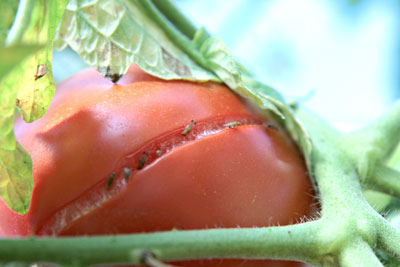 |
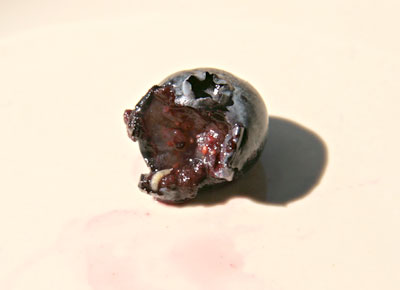 |
| Spotted wing drosophila on a cracked tomato | Drosophila larva in a blueberry |
SPOTTED WING DROSOPHILA
(Drosophila suzukii)
By Eric Sideman
The spotted wing Drosophila, as most of you know by now, is a species of fruit fly that, unlike the typical fruit fly found around overripe fruit, can pierce the skin of just ripe fruit and lay an egg. Most of you also know by now that the egg hatches and the larvae consume the fruit from the inside out. Watch out for soft fruit.
The fly is easy to recognize. It looks like a regular fruit fly, but there are spots on the wings.
Management is all about harvesting and post-harvest handling. Pick the fruit often and do not allow ripe fruit to hang around. After picking, refrigerate or freeze quickly. Do not leave baskets of fruit at room temperature, unless you want to raise maggots.
Spinosad (Entrust or Monterey Garden Spray) is actually very effective, however not practical nor, in most situations, legal. The problem is that the fruit fly has a very quick and large ability to reproduce. The populations become very large by late summer. Spraying would have to happen every 3-5 days to be really effective, and there is a label limit of only 3 sprays per crop. So, management for organic growers is all about harvesting and post-harvest handling.
A great new guide to organic management of spotted wing Drosophila was released last year, and the pdf file can be found here.
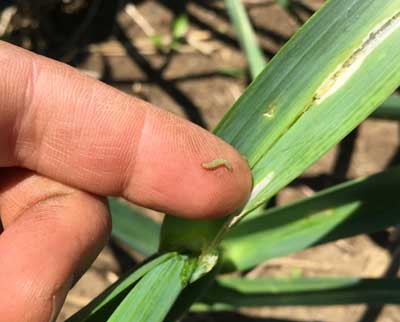 |
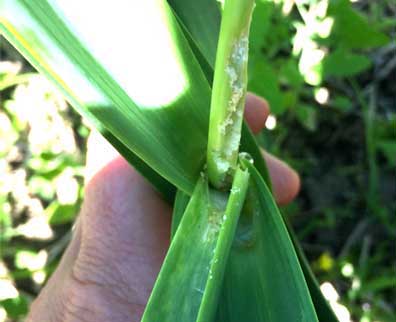 |
| Leek moth caterpillar. Photos courtesy of Scott Lewins | Leek moth caterpillar. Photos courtesy of Scott Lewins |
LEEK MOTH
(Acrolepiopsis assectella)
Leek moth is a newer invasive pest of allium crops like onions, garlic, shallots, chives, and as the name suggests – leeks. First introduced to Canada in 1993, it has been making its way south and east, and was reported in the northwest of Maine for the first time in 2017. Most growers in Maine will not see this pest this year, next year, and maybe not even for years to come, however, it’s important to know what to look for so that growers can help each other track the spread of this pest, and not be caught blindsided when it does arrive.
As with most moth pests the real damage is from its larval caterpillar stage, of which there are two to three generations. Feeding damage first stunts growth as leaves are attacked, and later can impact storage and saleability of onions, garlic, and leeks as the second generation may eat its way in the direction of the bulb. If leek moth caterpillars are feeding on allium leaves at the time of harvest, the caterpillars will move into the bulbs as the leaves die down. Feeding damage and exit holes on bulbs while in storage can significantly reduce their marketability and open the bulbs up to secondary infection.
On flat-leaved garlic and leeks, the damage is often visible on the inside surface of the leaf, near the mid-rib, or in the garlic scape. In onions, damage can look similar to that of a leafminer because the caterpillar chews its way into the circular leaf, eating the interior layers of the leaf but leaving the waxy outer layer intact (‘windowpane’ damage).
Organic control options are limited, though a predatory wasp has been released in Canada, and will hopefully follow the pest across the border as well. The best practice for now is to use row cover to prevent adult moths from laying eggs on your crop. Row cover can be removed during the day to cultivate or harvest, as adult leek moths only fly at night. Spinosad (Entrust or Monterey Garden Spray) can be effective if applied 7 – 10 days following a peak flight.
Keep your eyes peeled for this new pest, and please let us know if you see it. Similar looking damage can occur from onion thrips, salt marsh caterpillar, or simply chlorotic leaf spots from several diseases (e.g., botrytis, purple blotch). There are a lot of helpful photos and more information at the leek moth information center website.

